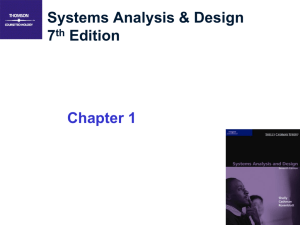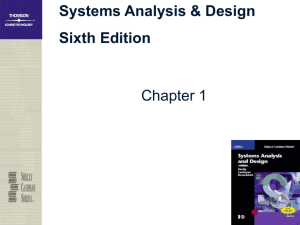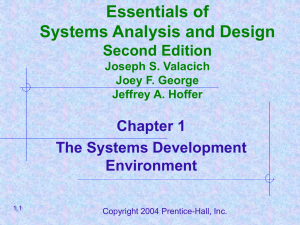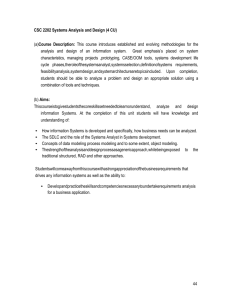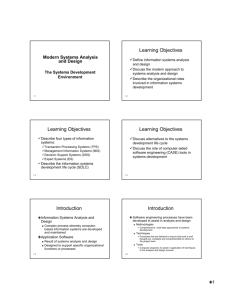System Analysis and Design
advertisement
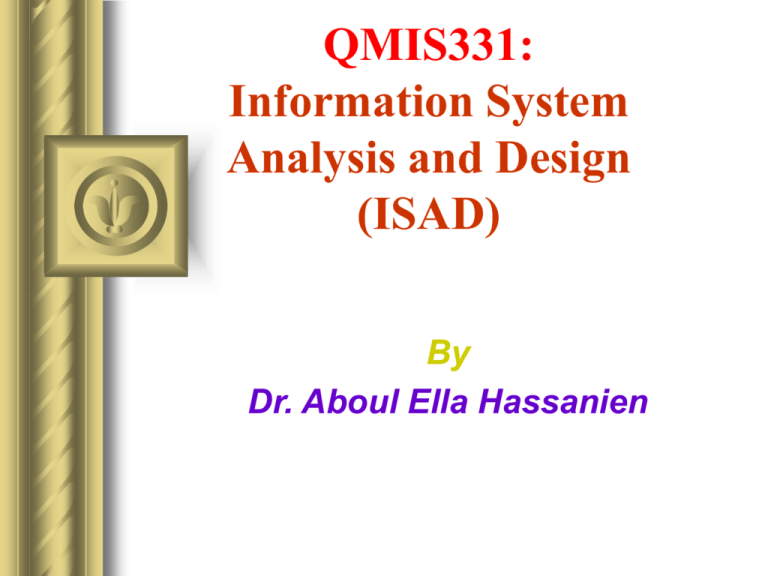
QMIS331: Information System Analysis and Design (ISAD) By Dr. Aboul Ella Hassanien Lecture Meeting and Location Lecture Meeting: – Saturday – Monday – Wednesday – 8.00 8.50 – Location: Room # 311 – Office Hours: • Sat & Monday 9.00 -10.00 Required Text Book Modern System Analysis & Design, 4th Jefferey A. Hoffer, Joey F. George and Joseph. S. Valacich, Prentice-Hall, 2005 Course Objective To provide you with new ways of looking at information in the world in order to solve business problems To introduce you to concepts and methods of SAD To describe the systems development life cycle (SDLC) To teach you effective methods for gathering essential information during system analysis To teach you effective methods for designing systems to solve problems effectively using technology Chapter-1: The Systems Development Environment – – – – Basic concepts of IS System analysis and design definition SAD: Discuss modern approach Discuss Organizational Roles • System analyst – Information system types – SDLC :The System Development Life Cycle Using CASE tools (Computer Aided Software Engineering) Systems Theory What is a System? Systems and Subsystems Business organization as a Sociotechnical system Information Systems (IS) as a system What is a System? A collection of parts that work together to achieve a goal/task – Examples • • • • • • Solar system Digestive systems Public transport system Central heating system Computer system Information system A set of objects and relationships among the objects viewed as a whole and designed to achieve a purpose System Elements INPUT PROCESS FEEDBACK OUTPUT Systems Can Be Composed of Subsystems System Subsys A Subsys B Subsys A-1 SubsysB-1 Subsys A-2 SubsysB-2 Subsys A-3 Elemental part B1 Elemental Part C What is subsystem? A subsystem is simply a system within a system. – Automobile is a system composed of subsystems: • • • Engine system Body system Frame system – Each of these subsystem is composed of sub-sub --systems. • Engine system: carburetor system, generator system, fuel system, and so son Bad Systems Fail to meet requirements Poor performance Poor reliability Lack of usability Example difficulties: – Not to schedule – Not to budget – Runaway = 100% over budget or schedule Some problems are simply “wicked” problems Reasons for Failure Complexity – – – – Shifting requirements Bad estimation Bad management New technology Must tackle complexity by, for example: – Structure partitioning of problem – Organized interaction of parts – Ensure you achieve the task Systems are subject to the need for continuing change Important System Concepts Decomposition – The process of breaking down a system into smaller components – Allows the systems analyst to: • Break a system into small, manageable subsystems • Focus on one area at a time • Concentrate on component pertinent to one group of users • Build different components at independent times 1.14 Important System Concepts Modularity – Process of dividing a system into modules of a relatively uniform size – Modules simplify system design Coupling – Subsystems that are dependent upon each other are coupled Cohesion – Extent to which a subsystem performs a single function 1.14 Computer-based Information Systems (CBIS) vs Manual Systems CBIS – Information system that rely on computer hardware and software for processing and disseminating information Manual systems – Use paper + pencil technology CBIS Components A Computer-based Information System = Hardware + Software + People + Procedures + Information Data and Information – Data are raw facts about the organization and its business transactions. Most data items have little meaning and use by themselves. – Alternative definition: • Data are a collection of items such as words, numbers, images, and sounds that are not organized and have little meaning individually • Data are raw facts about people, objects, and events in an organization – information: Data that is organized Data flow and processing logic Data flow: – Data in motion, moving from one place in a system to another Processing logic: – The steps by which data are transformed or moved and a description of the events that trigger these steps Processing logic example Events: H-W = 0 Event-action: If H-W > 40 then Pay = 40 *Pay-rate + (H-W – 40 ) *(1.5 *Pay-rate) Else Pay = Pay-rate *H-W End if -- H-W …. Worked Hours Databases A shared collection of logically related data designed to meet the information needs of multiple users in organization. Database – Files – Records -- Fields Levels of data managements databases Record 1 File 1 File 2 Record 2 Record N Filed 1 Filed 2 Character BYTE Character BYTE Character BYTE Filed N File N Traditional vs database approach Traditional approach Payroll system Tax data Personal data Redundant data Project Management System Personal data Project data Traditional vs database approach Database approach Payroll system Tax data Personal data Project Management System Project data Approach to system development There are three strategies of IS development 1. Process-oriented approach 2. Data-oriented approach 3. Object-oriented approach Process-oriented approach • An strategy to IS development that focuses on how and when data are moved through and changed by an IS Data-oriented approach • An strategy to IS development that focuses on the ideal organization of data rather than where and how data are used. Object-oriented approach • A system development methodologies and techniques base on objects rather than data or process Application independence The separation of data and the definition of data from the applications that the use these data Example Process Oriented Approach Rent books system Rent house system Personal Link Personal data Is missing data Book data Rent books system Data oriented House data Rent house system Application independence Book data Personal data House data Your Role and Other Organizational responsibilities in systems development Executive IS dept Dbase Admin. Director IS Devolp Manager IS dept Director Operations Manger Programming Manager Voice Comm Director Telecomm Manager Data Comm What is an Information Systems? Interrelated components working together to – Collect – Process – Store – Disseminate information To support decision making, coordination, control, analysis and visualization in an organization What is an Information System? A SYSTEM THAT PROVIDES THE INFORMATION NEEDED TO ACCOMPLISH THE ORGANIZATION’S TASKS WHAT IS A COMPUTER BASED INFORMATION SYSTEM? A SYSTEM THAT USES COMPUTERS TO PROVIDE THE NEEDED INFORMATION Information System Types 1. Transaction Processing Systems (TPS) 2. Management Information Systems (MIS) 3. Decision Support Systems (DSS) 4. Expert System and Artificial Intelligence (ES &AI) Transaction Processing Systems (TPS) TPS are computerized information systems that were developed to process large amounts of data for routine business transaction. Automate the handling of data about business activities and transactions, which can be thought of a simple discrete events in the life of an organization. – – – – – Data about each transaction are captured, Transactions are verified and accepted/rejected, Validation transactions are stored for later aggregation. Report may be produced to provide summarization of the transactions, and Transaction may be moved from process to process in order to handle all aspects of the business activities. Management Information Systems (MIS) Information system at the management level of an organization that serves the functions of planning, controlling, and decision making by providing routine summary and exception reports. It takes the relatively raw data available through a TPS and converts them into a meaningful aggregated form that mangers need to conduct their responsibilities. Developing an MIS calls for a good understanding of what kind of information managers require and how managers use information in their jobs. Decision Support systems (DSS) Information system at the management level of an organization that combines data and sophisticated analytical models or data analysis tools to support semistructured and unstructured decision making. DSS are designed to help organizational decision make decision. A DSS is composed of a: – Database ( may be extracted from a TPS/MIS) – Graphical/mathematical models for business process – User interface that provides a way to communicate with DSS Expert System and Artificial Intelligence (ES & AI) Knowledge representation describes the way an expert would approach the problem. It attempts to codify and manipulate knowledge rather than information, (for example if .. Then rule) User communication with an ES via an interactive dialogue. The ES asks questions ( that an expert would ask) and the end user supplies the answers. The answers are then used to determine which rules apply and the ES provides a recommendation based on the rule. Knowledge Engineers perform knowledge acquisition; they are similar with system analyst but are trained to use different techniques. Information Systems Applications System development for different IS types 1- TIS – IS characteristic: • High volume, data capture focus – System development methods: • Process-oriented • Concern with capturing, validating, and storing data with moving data between each required step System development for different IS types 2- MIS – IS characteristic: • Draws on diverse yet predictable data resources to aggregate and sumamrize data – System development methods: • Data-oriented • Concern with understanding relationship between data so data can be accessed and summarize in a variety ways System development for different IS types 3- DSS – IS characteristic: • Provide guidance in identifying problem, finding and evaluating alternative solutions and selecting or comparing alternatives; potentially involves groups of decision making – System development methods: • Data- and decision logic orientation • Design of user dialogue; group communication may be key an access to unpredictable data may be necessary • System development for different IS types 4-ES – IS characteristic: • Provide expert advice by asking users a sequence of questions dependent on prior answers that lead to a conclusion or recommendation – System development methods: • A specialized decision logic orientation in which knowledge is elicited from experts and described by rule or other form Stakeholders: Players in the Systems Game A stakeholder is any person who has an interest in an existing or new information system. Stakeholders can be technical or nontechnical workers. Stakeholders Classification For information systems, the stakeholders can be classified as: – – – – – – – IS manger Systems analysts in systems development Programmers in systems development End user in systems development Supporting End user development Business managers in systems development Other IS mangers/Technicians in system development IS Manger in Systems Development The manager of an IS department may have a direct role in the systems development process if the organization is small or I that is the manger’s style IS mangers are more involved in allocating resources to and overseeing approved system development projects rather than in the actual project development process. There are several IS mangers in any medium to large IS department. – The manger of an entire IS department may have the title Chief Information Officer and may report to the president or chairman of the firm. – Each division of the IS department will also have a manger • Director of IS development, IS operation manger, IS programmer director, etc. Systems Analysts Systems analysts are the key individuals in the systems development process. A systems analyst studies the problems and needs of an organization to determine how people, data, processes, communications, and information technology can best accomplish improvements for the business. The organizational role most responsible for the analysis and design of information systems. Skills of a Successful Systems Analyst Analytical skills – Understanding of organizations. – Problem solving skills – System thinking • Ability to see organizations and information systems as systems Technical skills – Understanding of potential and limitations of technology. 1.45 Skills of a successful systems analyst Managerial skills – Ability to manage projects, resources, risk and change Interpersonal skills – Effective written and oral communication skills – Help you work with end user as well as other system analysts and programmers 1.46 The analyst is responsible for: – The efficient capture of data from its business source, – The flow of that data to the computer, – The processing and storage of that data by the computer, and – The flow of useful and timely information back to the business and its people. Variations on the Systems Analysts Title A business analyst is a systems analyst that specializes in business problem analysis and technology-independent requirements analysis. A programmer/analyst includes the responsibilities of both the computer programmer and the systems analyst. Others • Systems consultant • Systems engineer • Information engineer The Systems Analyst as a Facilitator Skills Required by Systems Analysts – Working knowledge of information technology – Computer programming experience and expertise – General business knowledge – Problem-solving skills – Interpersonal communication skills – Interpersonal relations skills – Flexibility and adaptability – Character and ethics – Systems analysis and design skills Programmers in systems development Programmers convert the specifications given to them by the analysts into instructions the computer can understand. Coding: writing a computer program Code generators have been developed to generate code from specifications, saving an organization time and money. The aim of CASE tools (Computer-Aided Software Engineering) is to provide a variety of code generators that can automatically produce 90% or more from the system specifications normally given a programmer. Business managers in system development Another group to system development efforts is business managers such as functional department heads and corporate executives. These managers are important because they have the power to fund development projects and to allocate resources necessary for projects success. Other IS managers/ Technicians in system development Database ----- database administrator Network and telecommunications experts: – Manager of Data Communication – Manager of Voice Communication Internal auditors Characteristics of successful teams The characteristics are diversity in backgrounds, – skills, and goals; – tolerance of diversity, uncertainty, and ambiguity; – clear and complete communication; – trust; – mutual respect and putting one's own views second to the team; – A reward structure that promotes shared responsibility and accountability. System Analysis and Design (SAD) Systems Analysis: understanding and specifying in detail what an information system should do System Design: specifying in detail how the parts of an information system should be implemented Definition of SAD: – The complex organizational process whereby computer-based information systems are developed and maintained. System Analysis and Design (SAD) Analysis: defining the problem – From requirements to specification Design: solving the problem – From specification to implementation Why is it important? Success of information systems depends on good SAD Widely used in industry - proven techniques Part of career growth in IT - lots of interesting and well-paying jobs! Increasing demand for systems analysis skills Views of Systems Analysis How to build information systems How to analysis information system needs How to design computer based information systems How to solve systems problems in organizations System development methodology A standard process followed in an organization to conduct all the steps necessary to: • • • • Analyze Design Implement Maintain information system Systems Development Life Cycle (SDLC) It is a common methodology for systems often follows for system development in many organization, featuring several phases that mark the progress of the systems analysis and design effort. SDLC phases: – – – – 1-Project identification and selection 2-Project initiation and planning 3-Analysis 4-Design • 4.1Logical design • 4.2Physical design – 5-Implementation – 6-Maintenance 1.60 1-Project identification and selection phase – The first phase of the SDLC in which an organization total information systems needs are identified analyzed, prioritized and arranged. • Identifying Potential development projects • Classifying and ranking projects • Selecting projects for development – More details will be discuss in chapter (5) Cont. 1- Project identifying and selection This stage is critical to the success of the rest of the project. People: – Users, analyst, system managers coordinating the project Activities: – Interviewing user management, summarizing the knowledge obtained estimating the scope of the project and documenting the result Output: – Feasibility report: problem definition and summarizing the objectives 2-Project initiation and planning phase – The second phase of the SDLC in which a potential IS project is explained and an argument for continuing with the project is presented. A detailed plan is also developed for conducting the remaining phases of the SDLC for the propose system. Output are: • Detailed step – work plan - high level system requirement –assignment of team members – More details will be discuss in chapter (6) 3-Analysis phase The third phase of the SDLC in which the current system is studied and alternative replacement systems are proposed. – Description of current system – Where problem and opportunities are with a general recommendation on how to fix, enhance or replace current system – More details will be discuss in chapters (7-11) Cont. 3- Analyzing systems needs The primary objective of the analysis phase is to understand and document the business needs and the processing requirements of the new system. There are six primary activities in this phase: • Gather information. • Define system requirements. • Build prototypes for discovery of requirements . • Prioritize requirements. • Generate and evaluate alternatives. • Review recommendations with management 4-Design phase – The forth phase of the SDLC in which the description of the recommended solution is converted into logical and then physical system specification. • Logical design: – The part of the design phase of the SDLC in which all functional feature of the system chosen for development in analysis are described independently of any computer platform. • Physical design: – The part of the design phase of the SDLC in which the logical specification of the system from logical design are transformed into technology specific details from which all programming and system construction can be accomplished. – More details will be discuss in chapter (12-16) 4.1 Logical design output – Functional, – Detailed specification of all system elements • Input • Output • Process 4.2 Physical design output – Technical – Detailed specification of all system elements • • • • • programs, files, network, system software etc – Acquisition plan of a new technology Cont. 4- Designing the recommended system Its primary objective is to convert the description of the recommended alternative solution into system specification. – High-level design consists of developing an architectural structure for software programs, databases, the user interface, and the operating environment. – Low-level design entails developing the detailed algorithms and data structures that are required for program development. Seven major activities must be done during design: • • • • • • • Design and integrate the network. Design the application architecture. Design the user interfaces . Design the system interfaces. Design and integrate the databases. Prototype for design details. Design and integrate the system controls 5- Implementation – The fifth phase of the SDLC in which the information system is • • • • Coded, Tested, Installed, and Supported in the organization. – Outputs: • Code, documentation, training procedures and support capabilities – More details will be discuss in chapter (17) 6-Maintances – The final phase of the SDLC in which the information system is systematically repaired and improved – Output are: • New versions of releases of software with associated updates to documentation, training, and support More details will be discuss in chapter (18) Disadvantages of traditional SDLC It is too expensive (cost + time) when dealing with change once it is developed It is structured approaches that requires to follow all its phases Maintains costs are too expensive Improving the traditional SDLC 1. Structured analysis and structured design 2. Object oriented analysis and design 3. Prototyping 4. Joint Application Design (JAD) 5. Participatory design 1- Structured analysis and structured design More focus on reducing maintenances and time effort in system development Integrate change when needed 2- Object Oriented Analysis and Design (OOAD) – A more recent approach to system development that is becoming is object oriented analysis and design (OOAD). – It is often called third approach to system development, after the process oriented and data oriented approaches – Definition: OOAD • It systems development methodologies and techniques base on objects rather than data or process Object, Inheritance and object class Object: – A structure that encapsulates (packages) attributes and methods that operate on those attributes. An object is an abstraction of a real world thing in which data and processes are placed together to model the structure and behavior of the real world object – Combine data and processes (called methods) into single entities called Object Object class Group of objects that have the same attributes and behavior A set of objects that share a common structure and a common behavior (methods) Inheritance The property that occurs when entity types or object classes are arranged in a hierarchy and each entity type or object class assumes the attributes and methods of its ancestors. 3- Prototyping An iterative process of systems development in which requirements are converted to a working system that is continually revised through close work between an analyst and users. You can build prototype by some development tool to simplify the process. – CASE: Computer Aided Software Tools such as Oracle (designer 2000) – 4GLs: fourth-generation languages Prototyping is a form of Rapid Application Development (RAD)-------- Chapter 10 RAD disadvantages 1. RAD may overlook software engineering principles, 2. Resulting in inconsistencies among systems modules, 3. Noncompliance with standards, and 4. Lack of system component reusability The prototype methodology Identify problem Convert to Operational syst. Initial requirement Develop prototype Working prototype New requirement If prototype inefficient Implement & Use prototype Problems Next Version Revise& enhance prototype The prototype methodology 1. The analyst work with team to identify the initial requirement for the system: 2. The analyst then build the prototype. When a prototype is completed, the users work with it and then tell the analyst what they like and do not like about it. 3. The analyst uses this feedback to improve the prototype 4. Take the new version back the users 5. Repeat (2-4) until the users satisfied Prototype advantages 1. Prototyping involves the user in analysis and design 2. its ability to capture requirements in concrete rather than abstract form 3. To being used stand alone 4. It is may be used to augment the SDLC When I use Prototype 1. User requirements are not clear 2. One or few users and other stakeholders are involved with the system 3. Possible designs are complex and require concrete form to fully evaluate 4. Communication problem have existed in the past between user and analysts 5. Tools and data are readily available to rapidly build working systems 4-Joint Application Design (JAD) In the late 1970 systems development personnel at IBM developed a new process for collecting IS requirements and reviewing system design. It is called JAD Definition: It is structured process in which users, mangers, and analysts work together for several days in a series of intensive meeting to specify or review system requirements 5- Participatory design End users are involved in the SD around a table in one room to agree about system requirements and system design They responsible about the freeze of design “Milestone” Automated Tools and Technology Analyst rely on automated tools to: – Increase productivity – Communicate more effectively with users – Integrate the work that they do on the system from beginning to the end of the life cycle Examples: – Computer-Aided Systems Engineering (CASE -tools) – Application Development Environments (ADE -tools) – Process and Project Managers Improve productivity of IS development – Computing technology can be used to improve productivity. CASE tools, for example, provide many productivity enhancing capabilities, such as code generation, diagramming tools, and screen and report designing tools. Computer-Aided Systems Engineering: CASE tools – Computer-aided systems engineering (CASE) tools are software programs that automate or support the drawing and analysis of system models and provide for the translation of system models into application programs. Computer-Aided Systems Engineering: CASE tools – A CASE repository is a system developers’ database. It is a place where developers can store system models, detailed descriptions and specifications, and other products of system development. Synonyms include dictionary and encyclopedia. – Forward engineering requires the systems analyst to draw system models, either from scratch or from templates. The resulting models are subsequently transformed into program code. – Reverse engineering allows a CASE tool to read existing program code and transform that code into a representative system model that can be edited and refined by the systems analyst. CASE Architecture Chapter -1 The End
